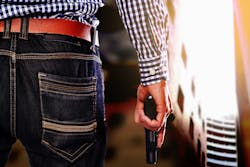COVID-19, the active shooter and liability
With the ongoing COVID-19 pandemic, businesses around the country are working diligently to reopen, however, their overall priority is for the health and safety of their employees, staff, and visitors. While monitoring and preparing for the coronavirus, businesses must be on guard for other potential crisis situations, such as an active shooter.
Businesses face a new reality that they must publicly disclose the potential impacts of targeted violence. Employers know that they have to satisfy the General Duty Clause, Section 5(a)(1) of the Occupational Safety and Health Act of 1970, requiring them to provide a workplace which is “… free from recognized hazards that are causing or are likely to cause death or serious physical harm”. This “duty of care” is a legal obligation employers have that ensures those on their premises or within the immediate vicinity have a reasonable expectation of protection from harm.
Every shooting event, especially those causing injuries or death, likely will be followed by a lawsuit against the business where the shooting occurred. For example, MGM paid $800 million to settle thousands of liability claims stemming from the 2017 mass shooting at the outside concert in Las Vegas that killed 58, wounded 413 and injured 869. In addition, the 2007 Virginia Tech University shooting resulted in $48.2 million of related liabilities with $38.8 million borne by the university and taxpayers.
In 2019 in the U.S., there were 434 mass shootings where 517 individuals were killed and 1,643 were injured. There is no way of predicting where the next active shooting will occur, but businesses can and must be prepared to take preventative measures to mitigate damage and protect workplaces.
These shootings continue to raise serious concerns and questions. Now with the COVID-19 pandemic, how do we strike a balance between safety and security? How do we change businesses from being soft targets? Is there security technology that can be a resource to business owners and emergency responders?
All businesses are unique, and their workplaces have their own individual challenges relating to size, age, location, design or type of construction, and other factors. Through careful planning, it is possible for businesses to develop a quality emergency/crisis plan that meets their specific needs.
All businesses should have emergency/crisis plans and lockdown procedures in place, train employees and staff, hold safety/security drills with emergency responders, and practice responses to different emergency situations, including an active shooter. In this regard, businesses should conduct a thorough risk assessment of all their facilities and properties with a security expert.
Any plan will undoubtedly include security technology, but no single security implementation will protect a business; true protection comes from many layers of security protocols and processes.
It is imperative to test your communication/fire systems frequently, including your PA system, phones, radios, duress buttons, fire alarms and other devices. Security screening systems can help spot guns, knives and other weapons at the entry or other areas. Cameras in and around your business have proven to be a strong deterrent in helping to ensure policies and procedures are being followed, as well as in assessing incidents after the fact. Cameras also provide a critical live insight for first responders during an emergency.
A gunshot detection and localization system that is integrated into a video surveillance system is highly effective and gets information out quickly. When every second counts, the best information available must be delivered instantly and intuitively for emergency responders to respond and react under the pressure of an active shooter situation. Also, if the video is transmitted over a network, it is possible to allow law enforcement personnel to view the cameras from their emergency command center and for the responding officers to view this from their vehicles.
Businesses should ensure they have a comprehensive safety and security plan in place and the plan should be a working document that is continually updated to meet today’s challenges. I have always stated that prevention costs less than reaction. A serious incident of violence is actually 100 times more expensive than taking pro-active measures to prevent the incident from occurring. Let’s protect what is important.
About the Author:
Patrick V. Fiel Sr. is a national security advisor working with Databuoy Corporation, the maker of Shotpoint, an acoustic gunshot detection and localization system. He is also the founder of PVF Security Consulting and presents on security trends, shootings, risk assessments, emergency/crisis preparedness and current security solutions. Fiel can be reached at (910) 789-4265 or at [email protected].
About the Author

Patrick V. Fiel, Sr.
Former Executive Director of Security for Washington, D.C. Public Schools
Patrick V. Fiel Sr., a national security expert with more than 40 years of experience in law enforcement and security management, is a retired member of the U.S. Army Military Police Corps. He is available to speak on risk assessments, active shooter preparedness and security best practices. He can be reached at (910) 789-4265 or [email protected].
